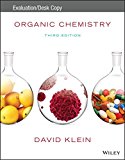
Concept explainers
(a)
Interpretation:
The trisubstituted pi bond and its configuration have to be identified and given.
Concept Introduction:
Z-isomer: when two groups with higher priorities are on same side of
E-isomer: when two groups with higher priorities are on opposite side of alkene double bond, then it is called as E-isomer. Priority depends on atomic number of atoms. Greater the atomic number, higher the priority.
(b)
Interpretation:
The total number of possible stereoisomers for pladienolide B has to be described.
Concept Introduction:
Stereo isomers: These are isomers, which are having same molecular formula but differ in their spatial arrangement. The number of stereoisomers in a compound with n number of stereocenters are
(c)
Interpretation:
The enantiomer of pladienolide B has to be drawn.
Concept Introduction:
Enantiomers: These isomers are non-superimposable mirror images. Enantiomers have same physical and chemical properties, but their ability to rotate plane-polarized light (+/-) by equal amounts are in opposite directions.
(d)
Interpretation:
The diastereomer identical to pladienolide B except for chiral center connected to ester oxygen has to be drawn.
Concept Introduction:
Diastereomers: These isomers are non-superimposable and not mirror images. It occurs when stereoisomers of a compound have different configuration at stereocenters and are non-mirror image.
(e)
Interpretation:
The diastereomer identical to pladienolide B except for configuration of disubstituted pi bond outside the ring has to be drawn.
Concept Introduction:
Diastereomers: These isomers are non-superimposable and not mirror images. It occurs when stereoisomers of a compound have different configuration at stereocenters and are non-mirror image.
Want to see the full answer?
Check out a sample textbook solution
Chapter 7 Solutions
Organic Chemistry 3rd.ed. Klein Evaluation/desk Copy
- The reaction Q(g) + R(g) → Z(l) is shown to be exothermic. Which of the following is true concerning the reaction. it is spontaneous only at High T, it is spontaneous at low T it is nonspontaneous at all T it is spontanrous at all T. it is non spontaneous only at low T.arrow_forwardThe reaction Q(g) + R(g) → Z(l) is shown to be exothermic. Which of the following is true concerning the reactionarrow_forwardWhich of the following has the largest standard molar entropy, S° (298.15 K) He H2 NaCl KBr Hgarrow_forward
- Which of the following is true for a particular reaction if ∆G° is -40.0 kJ/mol at 290 K and –20.0 kJ/mol at 390 K?arrow_forwardWhat is the major product of the following reaction? O O OH OH 1. BH 2. H₂O₂, NaOH OH OHarrow_forwardDraw the products formed when each ester is hydrolyzed with water and sulfuric acid.arrow_forward
 ChemistryChemistryISBN:9781305957404Author:Steven S. Zumdahl, Susan A. Zumdahl, Donald J. DeCostePublisher:Cengage Learning
ChemistryChemistryISBN:9781305957404Author:Steven S. Zumdahl, Susan A. Zumdahl, Donald J. DeCostePublisher:Cengage Learning ChemistryChemistryISBN:9781259911156Author:Raymond Chang Dr., Jason Overby ProfessorPublisher:McGraw-Hill Education
ChemistryChemistryISBN:9781259911156Author:Raymond Chang Dr., Jason Overby ProfessorPublisher:McGraw-Hill Education Principles of Instrumental AnalysisChemistryISBN:9781305577213Author:Douglas A. Skoog, F. James Holler, Stanley R. CrouchPublisher:Cengage Learning
Principles of Instrumental AnalysisChemistryISBN:9781305577213Author:Douglas A. Skoog, F. James Holler, Stanley R. CrouchPublisher:Cengage Learning Organic ChemistryChemistryISBN:9780078021558Author:Janice Gorzynski Smith Dr.Publisher:McGraw-Hill Education
Organic ChemistryChemistryISBN:9780078021558Author:Janice Gorzynski Smith Dr.Publisher:McGraw-Hill Education Chemistry: Principles and ReactionsChemistryISBN:9781305079373Author:William L. Masterton, Cecile N. HurleyPublisher:Cengage Learning
Chemistry: Principles and ReactionsChemistryISBN:9781305079373Author:William L. Masterton, Cecile N. HurleyPublisher:Cengage Learning Elementary Principles of Chemical Processes, Bind...ChemistryISBN:9781118431221Author:Richard M. Felder, Ronald W. Rousseau, Lisa G. BullardPublisher:WILEY
Elementary Principles of Chemical Processes, Bind...ChemistryISBN:9781118431221Author:Richard M. Felder, Ronald W. Rousseau, Lisa G. BullardPublisher:WILEY





